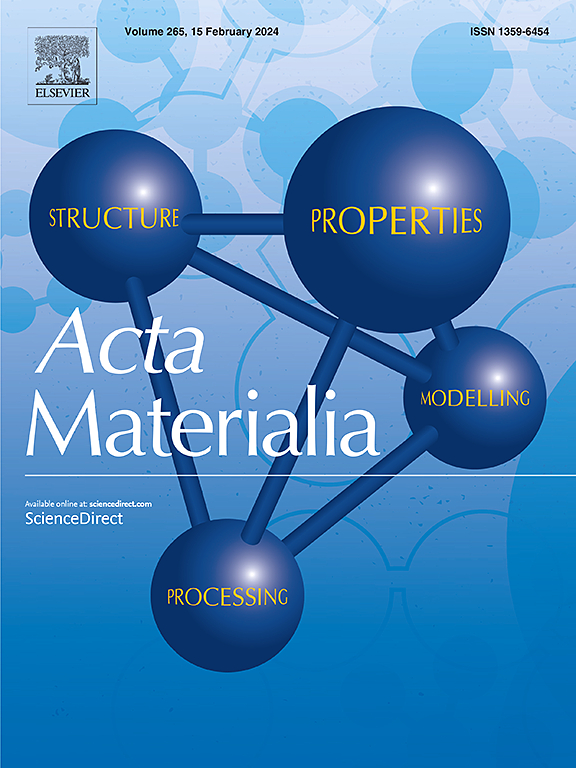通过异质结构复合工程设计超高强度轻质复合合金
IF 9.3
1区 材料科学
Q1 MATERIALS SCIENCE, MULTIDISCIPLINARY
引用次数: 0
摘要
同时提高合金的强度、延展性和抗裂性仍然是结构合金面临的巨大挑战,特别是那些采用双相异质结构的合金。虽然这些系统中的异质界面可以促进非均质变形和应变硬化,但它们通常充当应力集中器,引发界面应变局部化和过早破坏。在这里,我们报告了一种新的异质结构复合材料工程策略,同时最小化局部应变失配并提高界面裂纹容忍度。通过将Al和C引入轻质conv基复合合金(CCA)中,我们通过短时间退火(900 °C, 1 min)设计了独特的面心立方(FCC)/L21复合材料结构。该组织包括L21装饰的再结晶和非再结晶FCC区域,以及FCC嵌入的L21岛,在硬度和应变上形成梯度。这种结构显著降低了相间硬度对比(~ 1.5 GPa),从而激活了明显的非均质变形诱导(HDI)硬化,同时通过FCC和L21相之间的协同塑性抑制了应变局部化。所得CCA具有226 MPa·cm3/g的超高比屈服强度和14%的均匀延展性,优于先前报道的沉淀强化双相CCA。变形受多级应变硬化机制控制,包括HDI硬化、位错滑移、纳米孪晶和9R相的形成。此外,L21孤岛内的纳米孪晶和韧性FCC域作为有效的裂纹阻扰剂,延缓了裂纹的萌生和扩展。这项工作为通过分层复合材料工程设计具有优异力学性能的cca建立了新的范例。本文章由计算机程序翻译,如有差异,请以英文原文为准。


Designing ultrahigh-strength lightweight compositionally complex alloys through heterostructural composite engineering
Achieving a simultaneous enhancement in strength, ductility, and crack resistance remains a formidable challenge in structural alloys, particularly those employing dual-phase heterostructures. Although hetero-interfaces in such systems can promote heterogeneous deformation and strain hardening, they often act as stress concentrators, triggering interfacial strain localization and premature failure. Here, we report a novel heterostructural composite engineering strategy that concurrently minimizes local strain mismatch and enhances interfacial crack tolerance. By introducing Al and C into a lightweight CoNiV-based compositionally complex alloy (CCA), we engineer a unique face-centered cubic (FCC)/L21 composite architecture via a short-time annealing (900 °C, 1 min). This microstructure comprises L21-decorated recrystallized and non-recrystallized FCC regions, as well as FCC-embedded L21 islands, forming a gradient in both hardness and strain. Such a configuration significantly reduces the interphase hardness contrast (∼1.5 GPa), thereby activating pronounced heterogeneous deformation-induced (HDI) hardening while suppressing strain localization through cooperative plasticity between FCC and L21 phases. The resulting CCA exhibits an ultrahigh specific yield strength of 226 MPa·cm3/g and a uniform ductility of 14 %, outperforming previously reported precipitation-strengthened dual-phase CCAs. Deformation is governed by multistage strain hardening mechanisms, involving HDI hardening, dislocation slip, nanotwinning, and formation of 9R phases. Additionally, nanotwins and ductile FCC domains within L21 islands act as effective crack arresters, delaying crack initiation and propagation. This work establishes a new paradigm for designing CCAs with exceptional mechanical performance through hierarchical composite engineering.
求助全文
通过发布文献求助,成功后即可免费获取论文全文。
去求助
来源期刊

Acta Materialia
工程技术-材料科学:综合
CiteScore
16.10
自引率
8.50%
发文量
801
审稿时长
53 days
期刊介绍:
Acta Materialia serves as a platform for publishing full-length, original papers and commissioned overviews that contribute to a profound understanding of the correlation between the processing, structure, and properties of inorganic materials. The journal seeks papers with high impact potential or those that significantly propel the field forward. The scope includes the atomic and molecular arrangements, chemical and electronic structures, and microstructure of materials, focusing on their mechanical or functional behavior across all length scales, including nanostructures.
 求助内容:
求助内容: 应助结果提醒方式:
应助结果提醒方式:


